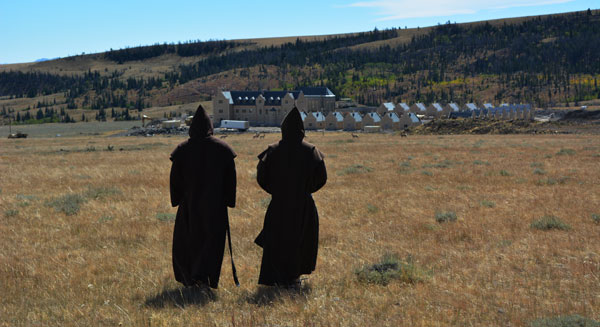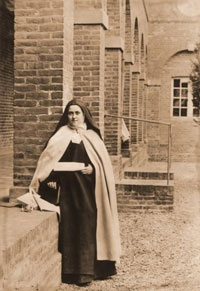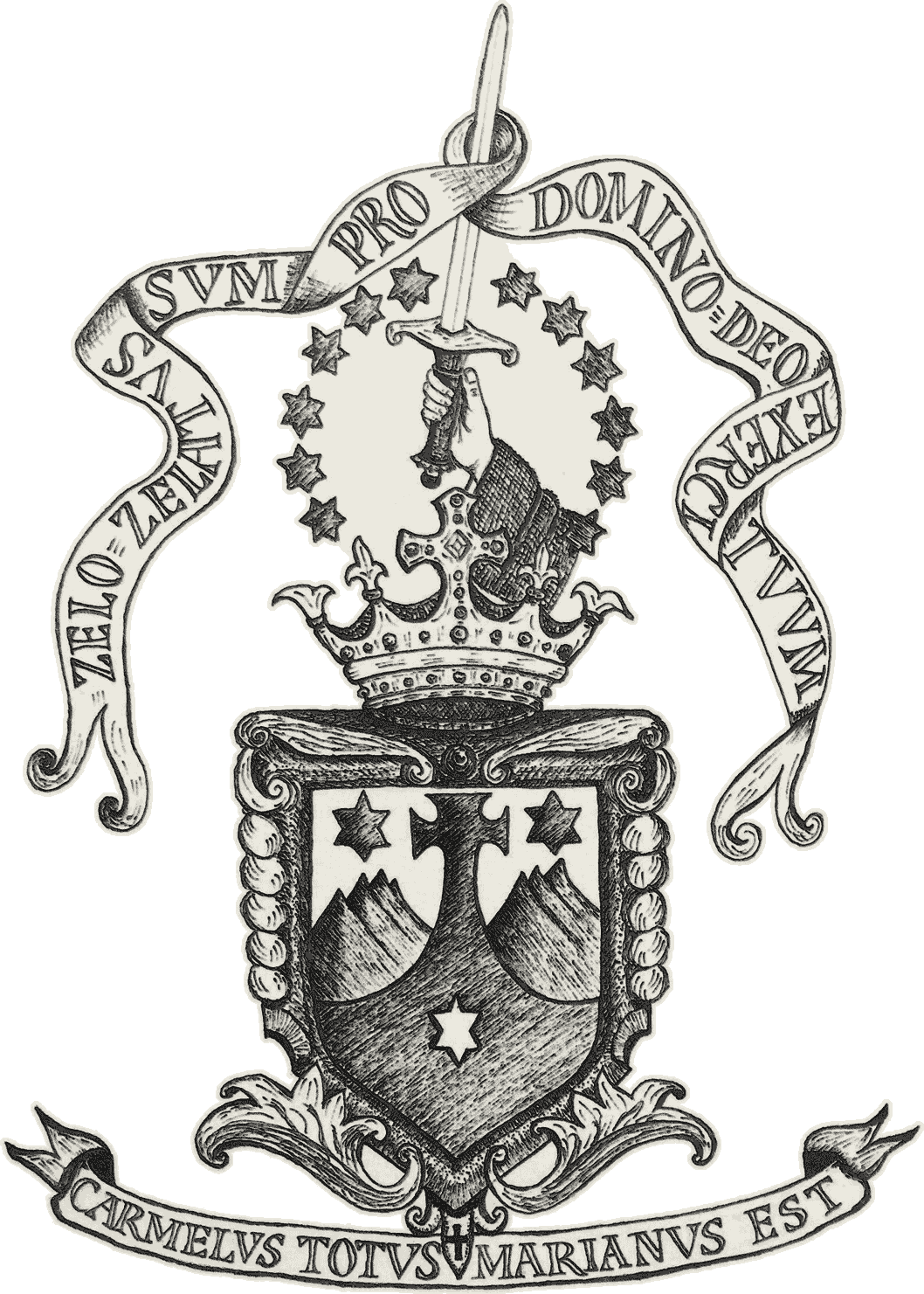WHERE DO I BEGIN TO DISCERN CARMEL? - AN INTRODUCTION.
Contact the Carmelite Vocations Director Here
"From the origins of the life of special consecration in the Church, men . . . called by God and in love with Him have devoted their lives exclusively to seeking His face, longing to find and contemplate God in the heart of the world. The presence of communities set like cities on a hill or lamps on a stand, despite their simplicity of life, visibly represent the goal towards which the entire ecclesial community journeys . . . contemplative communities, which 'by virtue of their separation from the world are all the more closely united to Christ, the heart of the world' . . . Contemplatives, as men . . . immersed in human history and drawn to the splendour of Christ . . . are set in the heart of the Church." - Pope Francis

An introduction to Carmelite spirituality can be very daunting. With three doctors of the church and dozens of canonized saints, theologians and spiritual writers, where do you start? Here are our tips on where to begin to understand Carmelite spirituality. The following passages explain why God calls certain souls to be a hidden leaven in the cloisters of Carmel.
1) St. Therese of the Child Jesus and the Holy Face:
To get to the "heart" of where Carmel takes its place in the Church, we must of course begin with our little, glorious saint and Doctor of the Church St. Therese of the Child Jesus. In her childlike simplicity, she enumerates very clearly, in simple terms, the vocation of a Carmelite. You can download an exerpt of her writing where she speaks about the Carmelite vocation here:
she enumerates very clearly, in simple terms, the vocation of a Carmelite. You can download an exerpt of her writing where she speaks about the Carmelite vocation here:
St. Therese of the Child Jesus on the Carmelite Vocation
St. Therese in this passage explains her longing to give life to every apostolate in the Church through her Union with God. She grasps in a profound way the reality that God uses souls transformed in Him to be a channel of grace for the whole Church. She says, "I knew that the Church has a heart, that this heart burns with love, and that it is love alone which gives life to its members." This was St. Therese's vocation, to be love in the heart of the Church through a life profoundly given over to a cloistered, hidden Union with God. So is the pursuit of a cloistered Carmelite - Union with God through Our Lady for the building up of the entire Church.
For a complete book of Story of a Soul, you can download a pdf here: Story of a Soul by St. Therese.
This very profound reality of a religious so transformed in love as to give love to the entire Church was first grasped by another saint who had a great impact on St. Therese. She said that near the end of her life only one saint could feed her soul - St. John of the Cross.
2) St. John of the Cross: For more Carmelite spirituality of St. John of the Cross - click here.
Perhaps no other saint has been a better teacher and father of souls aiming at the heights of the spiritual life than St. John of the Cross, Doctor of the Church on Union with God. Hundreds of years before St. Therese, he too explained how a soul completely transformed in God through love could give God to souls. This was the essence of the spirituality of St. John of the Cross.
In the Living Flame of Love, St. John of the Cross develops his theology of a soul in Union with God. He says,"A reciprocal love is thus actually formed between God and the soul, like the marriage union and surrender, in which the goods of both . . . are possessed by both together." Here he is saying that the soul in Union with God has the right over God's gifts and so can distribute them to others as it wishes. "Having Him for its own, it can give him and communicate him to whomever it wishes." This ability and marriage of the soul with God is of course by grace and not by nature, since we are always creatures. Here too we see St. John agree with St. Therese, that a soul can attain to Union with God, and so help thousands of souls in the world it has never met. This is the important vocation of a cloistered Carmelite.

This may be a beautiful idea, but is it a reality attainable by everyone? This is an important question! If it is not attainable except by extraordinary saints, why should we little souls hope for something so profound?
St. John of the Cross answers this also. In the Living Flame of Love he explains that if a soul is emptied of all other loves, God will communicate Himself to the soul. By being emptied of other loves, St. John means all desires which are not God or in God, which is different from love of those we should love, like our families. He explains that when the soul is free from other loves, it is impossible for God not to communicate Himself to the soul. "It is more impossible than it would be for the sun not to shine on clear and uncluttered ground." It is because God is so good and generous, that he wants to exalt souls who are very little to such an exalted state, where they can help the whole Church by their Union with God.
Is this effect on the Church of a prefect soul in Union with God important? He says yes, more important than many great works done in the active apostolate. The soul obtains many graces for the active apostolate and through its Union with God, becomes a large channel of grace for those works. That is why the path to Union with God is so important.
Find out more about the Carmelite spirituality of St. John of the Cross here.
3) St. Teresa of Jesus: For more Carmelite spirituality of St. Teresa of Jesus - click here.
No other saint has explained the path to Union with God better than St. Teresa of Jesus, Carmelite Doctor of the Church on prayer. Her very practical way of attaining to the the innermost rooms of the interior castle was a mixture of prayer and the practice of the virtues. She begins with explaining the importance of mental prayer in the sanctification of a soul.
Communing with God in prayer is the direct path to holiness according to St. Teresa. She speaks in her Life about this interior relationship with Christ, "That no one ever took Him for His friend that was not amply rewarded; for mental prayer is nothing else, in my opinion, but being on terms of friendship with God, frequently conversing in secret with Him Who we know loves us." Through conversing with Our Lord and His Blessed Mother in personal prayer, the soul becomes more like them by the graces they give when communing with them. Over a life time of mental prayer, the soul is conformed more and more to God by its communing with God.
Progress in Union with God is proved by virtue and love for one's neighbor. St. Teresa explains, "The best sign that any one has made progress is that she thinks herself the last of all and proves it by her behavior, and that she aims at the well being of others in all that she does. This is the true test - not sweetness in prayer." Perfect conformity to God is about perfect love of God and of neighbor, and the proof of this love is in the love a soul has for others.
In particular, St. Teresa loved the virtue of obedience, because it is the virtue that leads most quickly to Union with God. In her Book of Foundations, she writes at great length about this virtue and how important it is since, "there is no way which leads more quickly to the highest perfection than that of obedience." In obedience the soul is most quickly conformed to Christ who was obedient even unto death on a cross. To attain to perfect love of God and Union with God, one must give God his will first. This gift of ourselves to God is accomplished most quickly and in the best way through obedience to one's superior, which is an integral aspect of a cloistered religious vocation.
No one loved the enclosed life of Carmel more than St. Teresa. So many mystical graces are given only inside the cloister, where souls, "living within the flowing waters of their Spouse," are inundated with the presence of God. She explained that, "No one who has not experienced it could believe the fullness of satisfaction we feel . . . when at last we find ourselves enclosed." The enclosure is the sealed up garden where God communes with souls who seek Union with Him through prayer and the practice of the virtues.
Find out more about the Carmelite spirituality of St. Teresa of Jesus here.
You can find many Carmelite saints books on spirituality here: Carmelite saints writings and books.
We have touched here only on a few passages from the Carmelite saints to give a very brief explanation of cloistered Carmelite Spirituality. If this resonates in your soul, feel free to contact the Carmelite Vocations Director below so that we can help you discern if you are called to this form of contemplative monasticism.

